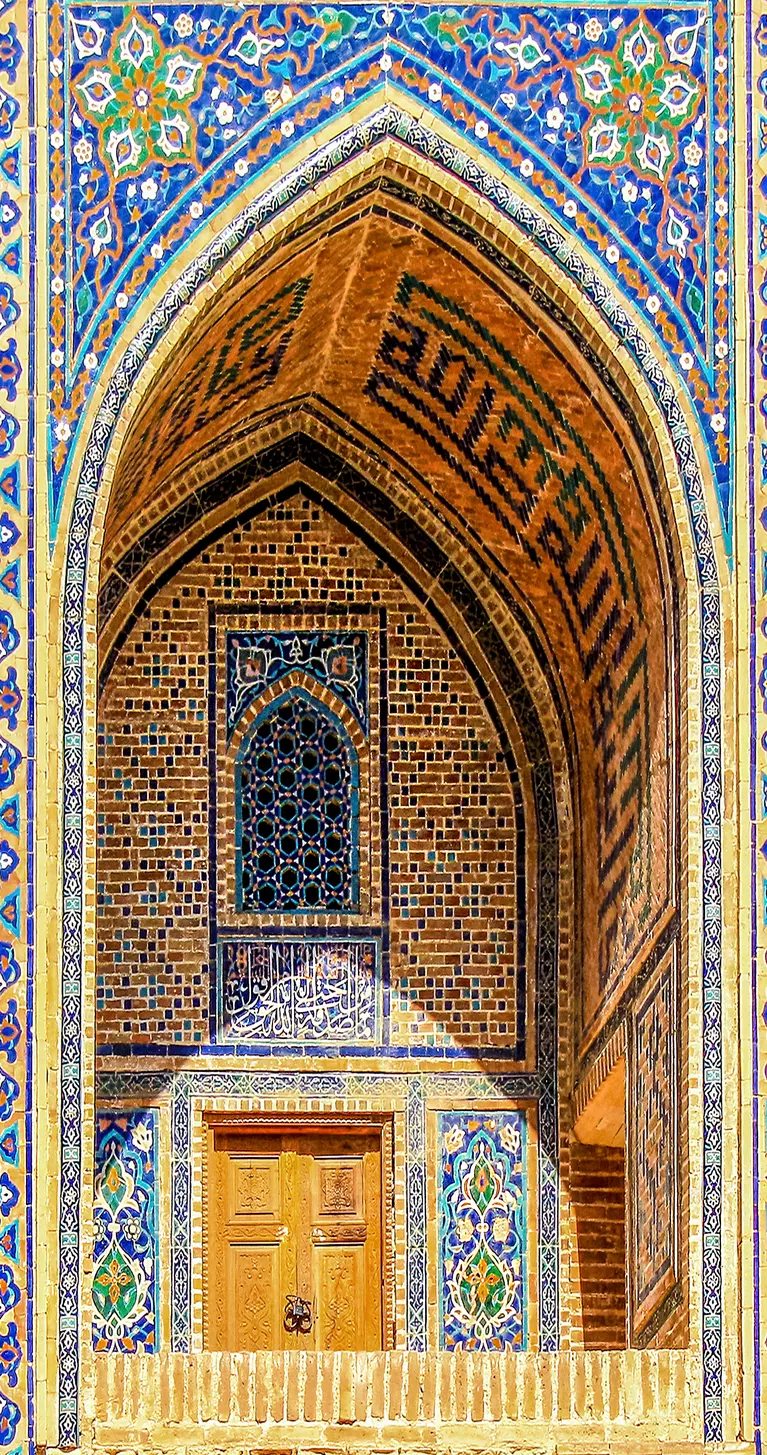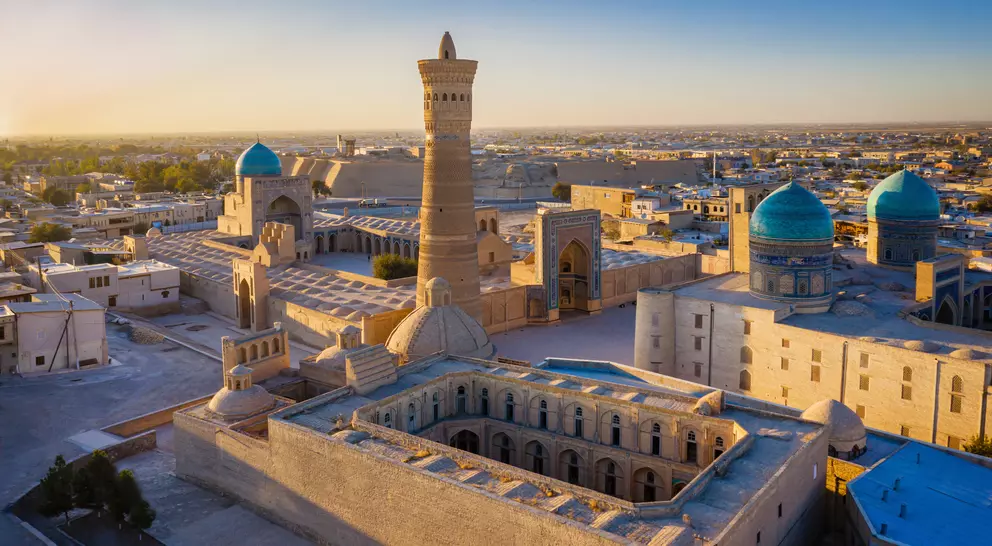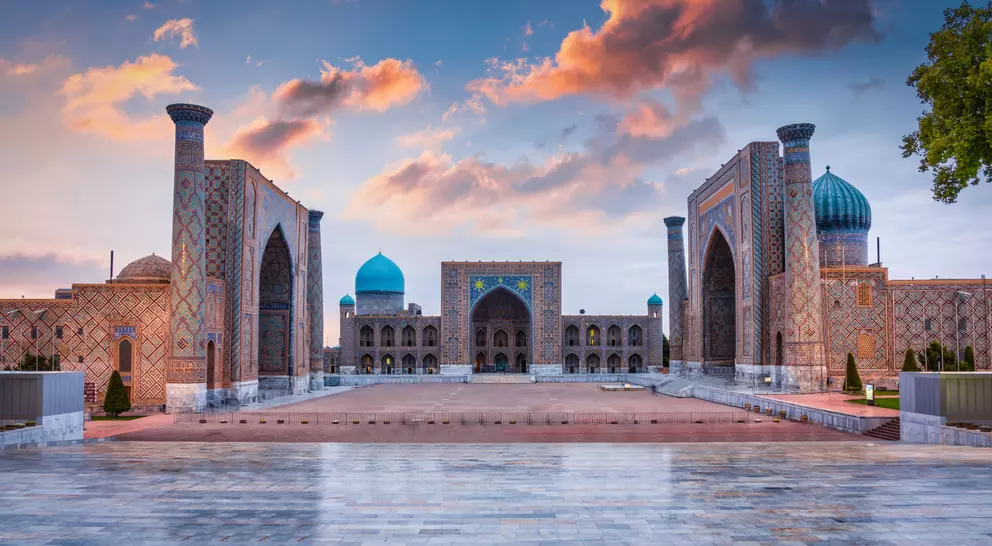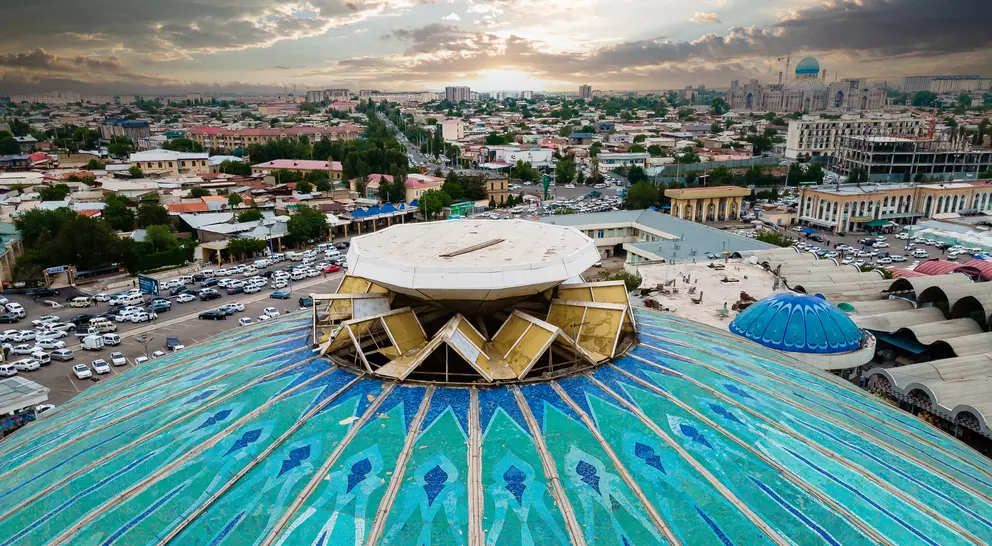US and Canadian citizens do not need a visa for tourist stays of up to 30 days. Your passport must be valid for at least three months beyond your visit. Registration with local authorities is required, but hotels typically handle this on your behalf. If travelling to restricted border areas, special permits may be needed—your guide or tour operator can arrange these.
Discover Tailor-Made Uzbekistan Vacations
Uncover Uzbekistan’s Silk Road treasures with ancient cities, vibrant bazaars, and striking Islamic architecture.
Uzbekistan enchants travellers with the legendary cities of Samarkand, Bukhara, and Khiva, each alive with history and culture. From turquoise-tiled mosques and desert fortresses to bustling markets and welcoming traditions, it offers a rich journey through Central Asia’s Silk Road past and present.
Featured Highlights
- Admire Samarkand’s iconic Registan Square
- Explore Bukhara’s mosques, minarets, and bazaars
- Step inside Khiva’s walled Ichan Kala old town
- Discover desert citadels in the Kyzylkum sands
- Enjoy hiking trails in Uzbekistan’s mountain ranges
- Savour plov, breads, and Uzbek hospitality
Featured Uzbekistan Trip Ideas
Step into Uzbekistan’s timeless Silk Road landscapes and culture.Travelling through Uzbekistan is like stepping into the heart of the Silk Road. Samarkand’s Registan Square glitters with blue-tiled madrasas, while Bukhara’s labyrinthine alleys reveal centuries-old mosques, minarets, and caravanserais. Khiva enchants with its walled Ichan Kala, a living museum of Islamic architecture. Beyond the historic cities, travellers encounter desert citadels, the Kyzylkum sands, and mountain landscapes ideal for hiking. The warmth of Uzbek hospitality shines through at every turn, with plov simmering in cauldrons, fragrant breads pulled from clay ovens, and stories shared over green tea. This is a country where history, tradition, and everyday life weave seamlessly together.
Best of Central Asia: Across the Stans
Almaty, Samarkand, Bukhara, and TashkentDon't see the
perfect trip idea?
Request a custom quote.
Turn your travel dreams into reality with Goway. Our customized vacations take travellers to all corners of the world.
What do Goway's travellers say?

Get to know Uzbekistan before you go.
Best Time to Visit
Spring in Uzbekistan offers an inviting blend of pleasant weather, blooming landscapes, and lively cultural gatherings. From March through early June, mild temperatures and clear skies make exploring the country’s ancient cities and natural wonders a joy, while light rain brings a refreshing brightness to the scenery.
May is a particularly rewarding month to travel, with warm days that suit both city sightseeing and journeys into the countryside. Visitors can expect a calendar filled with festivals, performances, and local celebrations, giving a deeper glimpse into Uzbek traditions. This is also the perfect time to wander through Samarkand’s majestic Registan Square, explore the narrow streets of Bukhara, or admire the desert blooms of the Nuratau Mountains. The comfortable weather makes guided tours and day trips especially enjoyable.
For travellers seeking a quieter experience, winter offers a different kind of charm. From December to February, Uzbekistan’s streets are calm, accommodation prices fall, and local festivities like New Year bring a festive atmosphere. The Tien Shan Mountains open their ski slopes, drawing adventure seekers keen on winter sports. However, cold temperatures, biting winds, and heavy snow in the north can make travel more challenging, occasionally disrupting plans.
Whether you’re drawn to Uzbekistan’s springtime energy or its winter solitude, timing your visit shapes the journey. Spring is ideal for those eager to combine history, culture, and nature, while winter appeals to travellers looking for affordability, quieter streets, and snow-covered adventures.
What do the experts say?
Try attending a plov cooking ceremony on your trip to Uzbekistan. It is a great regional, social ceremony featuring a delicious shared meal.
The warmth, hospitality, lively markets, the iconic turquoise domes, and modern life are my favourite parts about visiting Uzbekistan.
Places To Go
Handcrafted journeys to our most popular places to visit in Uzbekistan
Bukhara
Bukhara is Central Asia’s holiest city with a history and buildings spanning thousand of years. The...
Bukhara is Central Asia’s holiest city with a history and buildings spanning thousand of years. The old centre retains the look it had two centuries ago. During Uzbekistan travel, the city is crammed...

Samarkand
Samarkand, Uzbekistan’s second-largest city, is one of the oldest inhabited cities in Central Asia,...
Samarkand, Uzbekistan’s second-largest city, is one of the oldest inhabited cities in Central Asia, possibly founded around the 7th and 8th Centuries BC. Because of its location, it was an extremely...

Tashkent
Tashkent is the capital of Uzbekistan. Although it has a history dating back to the glory days of...
Tashkent is the capital of Uzbekistan. Although it has a history dating back to the glory days of the Silk Road, little remains of the ancient city due to an earthquake in 1966. On Uzbekistan tours,...
Travel Styles
Explore Uzbekistan by Travel Type
Ways to Travel
Discover your perfect travel style—crafted for every dream and journey.

Themes
Immersive adventures shaped by passion, such as food, culture, wellness, and wild discovery.

Ways to Travel
Discover your perfect travel style—crafted for every dream and journey.

Themes
Immersive adventures shaped by passion, such as food, culture, wellness, and wild discovery.
Frequently Asked Questions
Do I need a visa or special permits to enter Uzbekistan?
What language is spoken locally? How widely is English understood in Uzbekistan?
Uzbek is the official language, written in both Latin and Cyrillic scripts. Russian is widely spoken, especially in cities and for business. English is growing in tourism hubs like Tashkent, Samarkand, and Bukhara, where guides, hotels, and younger people often speak it. In rural areas, English is limited.
What are the must-see attractions in Uzbekistan?
The Silk Road cities are the country’s highlights. Samarkand dazzles with Registan Square and the blue-domed Gur-e-Amir Mausoleum. Bukhara feels like a living museum, with mosques, bazaars, and madrasas. Khiva, surrounded by ancient walls, offers one of the best-preserved old towns in Central Asia. Tashkent blends Soviet-era architecture with modern development, while the Fergana Valley is known for crafts and traditional culture. The Kyzylkum Desert provides wide open landscapes and yurt-stay experiences.
Is Uzbekistan safe? What should I keep in mind while travelling there?
Uzbekistan is generally very safe, with low crime rates. Petty theft is uncommon but can occur in crowded bazaars—keep valuables secure. Roads can be uneven, so take care if travelling by car or bus. Political gatherings should be avoided. The climate can be extreme, with very hot summers and cold winters, so plan activities accordingly.
What's the best way to travel within Uzbekistan?
High-speed trains like the Afrosiyob connect Tashkent, Samarkand, and Bukhara quickly and comfortably. Regular trains and domestic flights also link major cities. Shared taxis and buses operate between towns but can be slow and crowded. Walking is the best way to explore old city centres.
What Uzbek cultural customs should I be aware of?
Hospitality is central—tea is often offered, and it’s polite to accept. Dress modestly, especially outside big cities and at religious sites. Handshakes are common between men, but men and women usually greet with a nod or hand over the heart. Always remove shoes before entering a home. Bargaining in bazaars is normal but should be done respectfully.
What should I wear/pack for Uzbekistan's climate?
Uzbekistan has a continental climate with hot, dry summers and cold winters. In summer (June to August), pack lightweight, breathable clothing, a hat, and sunscreen. Spring and autumn are mild and ideal for travel—bring layers for cool evenings. Winter (December to February) requires a warm coat, gloves, and sturdy shoes. Modest clothing that covers shoulders and knees is best for visiting religious sites and rural areas. Comfortable walking shoes are essential for exploring historic cities.
Unlock more by subscribing to our newsletter
With our newsletter, you’ll get access to regular communications that inspire you and help you explore the world your way

